A Recipe from Rebeccca: Fish, Spinach, Garlic
This light, spring-some stew is green from the peas and spinach, and full of subtle fennel flavour. A punchy garlic mayonnaise adds richness and complexity. It’s really good with sourdough bread.
When we served this a week ago the guests were very surprised to learn the recipe comes from Sainsburys Magazine.
Simple Fish Stew with Aioli
Serves 4
Ingredients
For the Aioli
1 teaspoon salt
3 cloves garlic, peeled
1 egg yolk
1½ teaspoons lemon juice (or more to taste)
150ml olive oil
For the Fish Stew
2 tablespoons olive oil
400g celery stalks, finely chopped
400g fennel bulb, finely chopped
300g onions, finely chopped
3 springs dried or fresh thyme
Salt and pepper, to taste
3 bay leaves
1 teaspoon fennel seed
3 whole cloves
4 strips pared lemon zest
600-800ml water or fish/vegetable/chicken stock
800g skinless haddock or pollock fillets, cut into 4cm-wide chunks
3 tablespoons Pernod or other anise-flavoured liqueur
200g frozen peas
200g fresh spinach
To Serve
The aioli
Lemon wedges
Pepper flakes, if desired
Method
For the Aioli
Crush the salt and garlic in a mortar and pestle and place in the mini-bowl of a food processor, or the mixing container of your hand-blender. Add the egg yolk and lemon juice. Wizz up. With the motor running, very slowly drizzle in the olive oil, drop by drop. Continue adding the oil very slowly until the mixture begins to thicken, at which point you can increase your rate of drizzling in the oil to a thin stream. The mixture should thicken up nicely to form a thick mayonnaise. Set aside to let the flavours mellow.
For the Fish Stew
Heat a large pan with a lid over medium heat and add the oil. Once it is warm add the celery, fennel and onion, along with a pinch of salt and a grind of black pepper. Stir, reduce the heat to low, add the lid, and cook very gently for 5-15 minutes, until the vegetables are soft but not coloured. Add the herbs and spices, and strips of lemon, and stir for a few more minutes. Add 600ml of liquid and bring to a simmer. Simmer for 5 minutes (maybe 10 if you’re using water), to let the flavours meld. Now take a look: if there is not enough liquid to your taste, add the remaining water or stock and bring to a simmer.
Add the chunks of fish, cover again, and cook over low heat for about 3 minutes, or until the fish is beginning to look opaque on the top. Add the Pernod, peas and spinach and replace the lid. Turn the heat to medium and continue to cook for 2-3 more minutes, or until the spinach has wilted. The fish should be opaque on the top. Stir gently to blend everything together.
To Serve
Taste the aioli. Add more lemon juice, salt or pepper if you think the flavour needs boosting. Fish the bay leaves, cloves and thyme stems out of the stew if you wish (and can find them.)
Serve the stew, and let each person add a dollop of aioli to their bowl. Provide some lemon wedges and perhaps some red pepper flakes so people can personalise their bowl to taste. This is very nice served with good bread, and perhaps an additional drizzle of olive oil on both stew and bread.
Recipe adapted from Sainsburys Magazine, Feb. 2023
A Recipe from Rebecca: Roasted Carrot and Garlic Dip
‘This is delicious’, said a guest as we sampled Matt’s signature dirty martini a few weeks ago. ‘It is good, isn’t it?’, I replied. ‘No, I mean the dip’, he explained. It is good (and so were the martinis).
Roasted Carrot and Garlic Dip with Seed Dukkah
Serves 4-6 as a pre-dinner nibble.
Ingredients
For the Dip
500g carrots, unpeeled but cut into 2cm chunks
1 dried Canalside chile pepper
2 tablespoons olive oil + 1 more tablespoon olive oil (3 tablespoons total)
¾ teaspoon salt
1 whole head of garlic, left whole but with the top sliced off horizontally so you can see the actual garlic cloves
1½ tablespoons cashew or almond butter
1 lime, juiced (about 2 tablespoons)
For the Dukkah
1 tablespoon pumpkin seeds
1 tablespoon sunflower seeds
½ tablespoon cumin seeds
¼ teaspoon salt
¼ teaspoon sugar
½ teaspoon ufea chile flakes or any other mild chile flakes
Method
For the Dip: Heat the oven to the maximum setting (240C/220C fan). Line a baking tray with greaseproof paper.
Toss the carrots and chile pepper with 2 tablespoons olive oil and the salt. Spread on the baking tray.
Wrap the whole head of garlic in some foil and put that on the baking tray, too.
Put the baking tray in the oven and roast for 15 minutes. Remove the chile (set it aside), give the carrots and garlic a stir, and continue roasting them for another 15 minutes. Remove from the oven and set aside to cool a bit.
Once it is cool, unwrap the garlic and squeeze out the roasted garlic cloves into a small bowl.
Put the roasted garlic, carrots, chile, nut butter, and half the lime juice in a blender or food processer, and pulse until the mixture is coarsely blended. Season to taste with more salt or lime juice.
Transfer the dip to an attractive serving bowl and drizzle with the remaining tablespoon of olive oil and the remaining lime juice. Sprinkle with the dukkah (see below) and serve with something to dip into the dip. Sourdough crackers are good.
For the Dukkah: Heat a small, dry (i.e. no added oil) frying pan over medium heat. Add the seeds and stir, until everything seems a bit toasted. Let them cool a bit and then transfer them to a mortar along with the remaining ingredients. Bash them a bit until they are coarsely broken up.
Recipe adapted from Yotam Ottolenghi, Guardian, 26 June 2021
A Recipe from Rebecca: Miso-Butter Pasta With Squash
This recipe by Yasmin Fahr in the New York Times yields impressive flavour and a surprisingly creamy texture. As Fahr observes, it ‘hits all the right notes: sweet, salty and savory’. The lime juice and zest contrasts with the richness of the buttery squash or pumpkin, and the combination of miso, butter an cheese is magical. In fact, if you like this, and you will, then definitely try the NYT’s ‘five ingredient creamy pasta’ (https://cooking.nytimes.com/recipes/1020979-five-ingredient-creamy-miso-pasta).
Serve with a green salad. This is a great use of that Hallowe’en pumpkin, if that happens to be still hanging around.
Miso-Butter Pasta With Squash
Serves 4
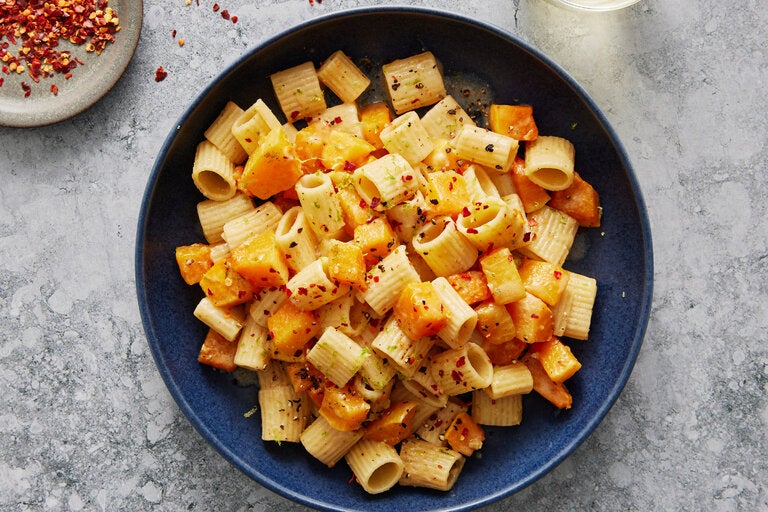
Ingredients
2 tablespoons unsalted butter, at room temperature
2 teaspoons white miso
3 to 5 large garlic cloves, crushed to a paste in a mortar and pestle with a little salt
1 tablespoon olive oil
Several grinds of black pepper
1 kilo squash or pumpkin, peeled and cut into 1cm cubes
500g rigatoni or other short pasta
50g grated Parmesan, plus more for serving
1-2 limes, zested and juiced, to yield 2 teaspoons zest and 2 tablespoons juice
Pinch of red-pepper flakes (optional)
Method
Heat the oven to 230C. Combine the softened butter, miso, crushed garlic and olive oil in a small bowl. Grind in some pepper. Dump the cubed squash or pumpkin onto a sheet pan and, using your hands, coat it in the miso-garlic butter. Spread it out evenly on the sheet pan, so the pieces are not all piled up on top of each other. Roast in the oven for 20-30 minutes, or until easily pierced by a fork.
When the squash or pumpkin has been roasting for about 10 minutes, bring a large pot of salted water to a boil. Add the pasta, adjusting the heat to maintain a gentle boil, and cook until just shy of al dente. Use a mug to remove about 250ml of the cooking water, and set aside. Now drain the rest of the water off the pasta.
When the squash or pumpkin is done, return the pasta to the pot over low heat. Scrape in the squash or pumpkin and any remaining miso butter, then add the Parmesan and about 100ml of the pasta water, stirring well until the noodles have a light sheen to them. If it appears dry, add more pasta water a little at a time until you reach your desired consistency. Stir in the lime zest and juice, season to taste with salt, pepper and the red-pepper flakes, if using. Serve with extra cheese.
Recipe by adapted from New York Times Cooking
A Recipe from Rebecca: Thomasina Miers’ Quail with Turkish Runner Beans
Quail cook in no time; you can order them from Aubrey Allen, in Leamington. Here the little birds are served on a bed of runner beans tossed with a spicy, roasted tomato and red pepper sauce, and topped with Greek yoghurt and a sprinkling of dill. Serve with good bread for a really special dinner.
Thomasina points out that the sauce is also delicious on pasta. Cook some spaghetti, and throw in some spinach a few minutes before it’s done. Drain (keeping back a teacup of the cooking water), return to the pan, and stir in the sauce, along with the teacup of water. Mix together over low heat for a minute or two, to allow the flavours to meld, and serve with some grated cheese.
Quail with runner beans and roast red pepper and tomato sauce
Serves four.
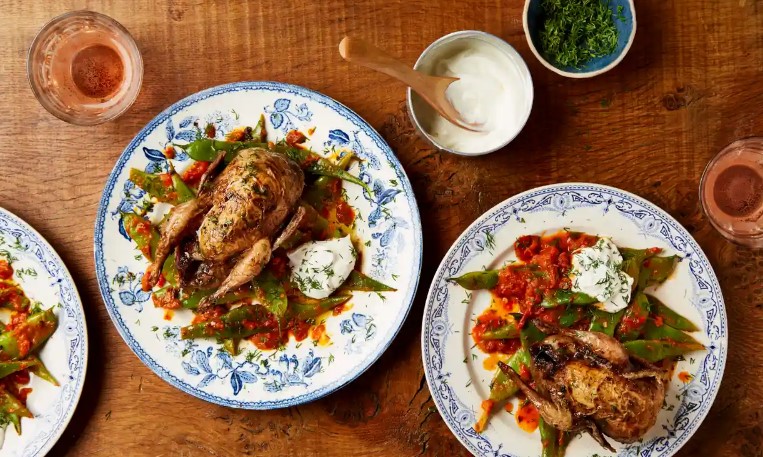
Ingredients
For the Turkish beans
2 red peppers
2 garlic cloves, skin left on
4 medium tomatoes, cut in half
salt and pepper
1 teaspoon thyme leaves, divided into two portions
2 tablespoons olive oil, plus extra to drizzle over the tomatoes and peppers before they roast.
700g runner beans, tough outer edges shaved off, and cut into 4cm lengths
For the quail
1 garlic clove, peeled
¼ teaspoon salt
½ teaspoon ground cinnamon
½ tsp ground allspice
2 tablespoons olive oil
4 quails
2 teaspoons harissa
To serve
Greek yoghurt
Fresh dill, finely chopped
Method
Prepare the Turkish beans: Heat the oven to 220C. Put the peppers and the 2 cloves of unpeeled garlic on one side of an oven tray and the tomatoes (skin side up) on the other. Season everything with salt, pepper, half the thyme, and a drizzle of oil. Roast for 20 minutes, then check on the garlic: if it’s soft, remove from the tray and set aside. If not, give it three or four minutes more. Turn over the peppers and return the tray to the oven for five to 10 minutes, until the peppers and tomatoes are slightly blackened. Set aside and leave for 10 minutes.
Once they are cool peel the skin off the peppers, using your fingers or a small knife. Discard the skin, and then cut in half. Remove and discard the seeds and stem. Slip the roast garlic out of its papery skin. Put the garlic, peppers and tomatoes in a food processor, add the remaining thyme, harissa and the two tablespoons of olive oil, and blitz to a coarse sauce. Season to taste and transfer to a medium saucepan.
Bring a pan of salted water to a boil and cook the beans for five minutes, or until al dente. Drain, and then tip the beans into the sauce. Mix together and cook on a low heat for five minutes, so the sauce thickens and reduces, and thoroughly coat the beans. Set aside; when you are ready to serve reheat it over a gentle flame until it is warmed through.
Prepare the Quail: Preheat the oven to 220C. Crush the garlic to a rough paste in a pestle with the salt, then add the cinnamon, allspice and two tablespoons of oil. Put the quail on an oven tray and rub all over with the spiced oil. Roast for 25-30 minutes, until the skin is crisp and the legs come away easily from the sides. Leave to rest for 10 minutes.
To serve, spoon some of the beans on to the centre of each plate and top with a quail. Finish with a dollop of yoghurt and a scattering of chopped dill.
Recipe adapted from The Guardian, 2017
A Recipe from Rebecca: Vicki Behm’s Lentil Salad
Vicki Behm is an outstanding cook, and this is a very good salad. As the name implies, it keeps well, in addition to being tasty. Consider packing some in a box to take to work for lunch. I think you could use other types of green olive if you don’t have any Castelvetrano olives to hand.
Make-Ahead Lentil Salad, 4 servings
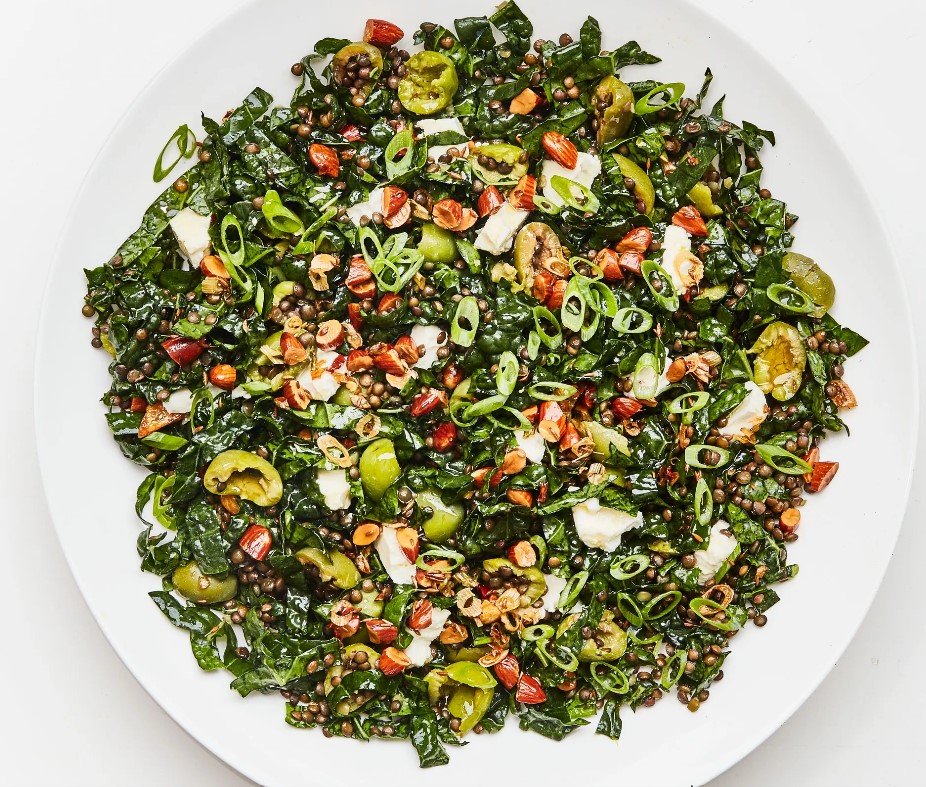
Ingredients
1 large bunch kale
12 ounces (measured in a measuring jug) of puy lentils
3 spring onions
4 garlic cloves
1 lemon
4 tablespoons olive oil
4 tablespoons raw almonds, coarsely chopped
1 tablespoon cumin seeds
½ teaspoon crushed red pepper flakes
140g feta
150g Castelvetrano olives, crushed with the side of a knife, and pits removed
salt
Method
Strip the kale leaves off the stems; discard stems or save for later. Stack the leaves on top of each other, then roll into fat cigars. Slice crosswise into ½ cm strips to form long, thin ribbons. Unfurl the ribbons. If any are really, long cut these into shorter ribbons that will be easier to get into your mouth. Transfer the ribbons to a large bowl, season with salt, and then use your hands to massage the kale: scrunch the kale up in your hands for 1 to 2 minutes, until it is silkier, softer, and darker in colour. This makes it more tender and nicer to eat raw. Place the kale ribbons in a large serving bowl.
Bring a large pot of heavily salted water to a boil over high heat. Add the lentils, reduce heat to medium, and simmer, uncovered, until the lentils are tender but still al dente, about 20–25 minutes. Try not to overcook them or they’ll be mushy.
While the lentils are cooking, prepare the spiced oil. Trim the spring onions and separate white and green parts. Thinly slice the white parts and transfer to a small skillet. (Keep the green parts—they will be used later in the recipe.) Peel the garlic and crush it with a knife. Add those to same skillet. Using a vegetable peeler or paring knife, remove three 8cm strips of lemon peel (avoiding white pith); reserve the rest of the lemon for your salad dressing. Add peels to skillet as well. Now pour the olive oil into skillet and stir so that all of the elements are coated in oil.
Heat the skillet over medium heat. Cook, stirring occasionally, until the garlic starts to brown and the lemon peel starts to curl, about 3 minutes. Add the almonds and cook, stirring frequently, until almonds are browned, about 3 more minutes. Remove from heat and stir in the cumin seeds and red pepper flakes—the residual heat from the oil will warm those spices and bring out their flavours.
Strain the oil mixture through a fine-mesh sieve into a small bowl, shaking to help the oil drain. Don’t throw away the stuff in the sieve! The oil will form the base of your salad dressing and the stuff in the sieve will add crunch to the salad. Spread the contents of the sieve on a paper towel-lined plate, season with salt, and let cool. The nuts will get crunchier as they sit.
Crumble the feta into the bowl with the kale. Tear the olives into large pieces and add them to the bowl as well. Thinly slice the reserved spring onion greens and add most of them to the bowl, reserving just a few for a garnish. Juice the lemon and add it, along with ½ teaspoon salt, to the serving bowl.
Once the lentils are cooked, drain them well, shaking to get rid of excess moisture, and add to bowl; season with salt. Add the infused oil and half of almond-spice mix, and toss to combine. Garnish with the remaining nuts and spices, and spring onion greens, and serve.
Recipe adapted from Bon Apétit, 2020
A Recipe from Rebecca: Refrigerator Pickles
My grandmother used to make refrigerator pickles, which (as the name implies) need to be stored in the fridge. Here is an easy recipe for converting an abundance of courgettes into crisp, dilly pickles to have alongside your sandwich or in a burger.
Refrigerator Courgette Pickles
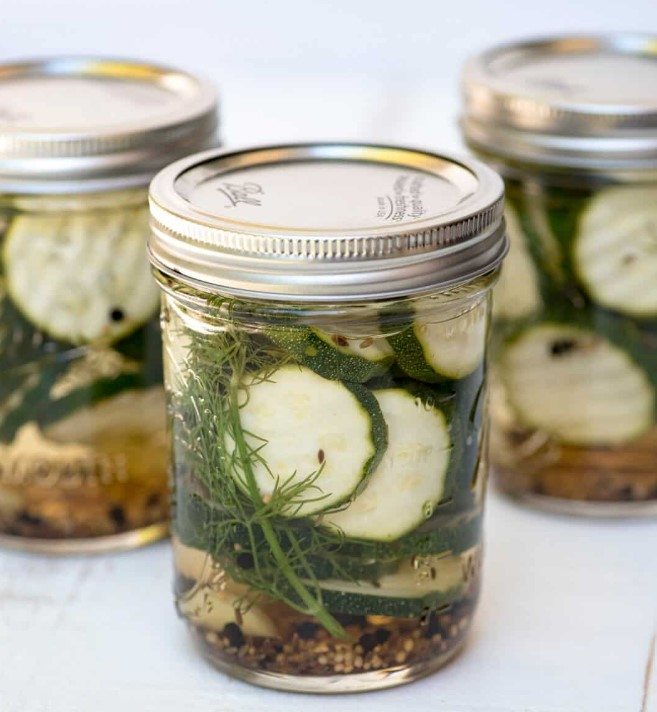
Ingredients
For the Pickles
3 garlic cloves, peeled and halved
1½ teaspoons black peppercorns
1½ teaspoons mustard seed
6 sprigs of fresh dill
700g courgettes
For the Brine
500ml water
250ml white vinegar
4 tablespoons sugar (I used muscovado)
2 tablespoons coarse sea salt
Method
Sterilise the jars in which you intend to store the pickles by pouring boiling water over them; you’ll need about 4 normal-sized jam jars or the equivalent. (See note below, as well.)
Divide the garlic, peppercorns, mustard seed and dill between them.
Wash, top and tail the courgettes. Slice into circles or spears, as you prefer, and pack neatly into the jars. Leave a bit of space at the top of each jar, so the courgettes can be covered completely in the brine.
Heat the brine ingredients over medium-high heat in a saucepan and boil until the sugar and salt dissolve.
Carefully pour the brine into your jars, put on the lids, and let cool to room temperature. (See note below, as well.)
Give the jars a good shake to distribute the spices and then store in the fridge for at least 24 hours before eating. They should last for some weeks.
NOTE: If the courgettes float to the surface you might want to weigh them down with something, to ensure they remain submerged in the brine, e.g. a smaller jam jar, ramekin dish etc. Make sure you sterilize these, too, with boiling water.
Recipe adapted from Valerie Brunmeier, Valerie’s Kitchen (2017)
A Recipe from Rebecca: Cumin-Scented Greens with Eggs, Feta, Lemon and Herbs
Shakshuka usually consists of eggs poached in a spicy tomato sauce. This is a green version, where the eggs are poached on top of a savoury mixture of cumin-scented greens, and then topped with feta, lemon and herbs. Serve it with good bread and some harissa if you’d like to spice it up a bit. Red or green, shakshuka is apparently a popular North African and Middle Eastern breakfast dish. It is also very nice for dinner, and uses only one pan.
We made it with some amazing duck eggs, which are huge and extra unctuous, so if you happen to have some lying around this is a good opportunity to use them. Ordinary eggs will be delicious too, though.
Green Shakshuka

Serves 2
Ingredients
3 tablespoons olive oil
1 large onion, roughly chopped
½ teaspoon salt
2 teaspoons cumin seed
1 teaspoon coriander seed
2 large garlic cloves, sliced thin
650-ishg greens (spinach, chard, spring greens, or a mixture), chopped
25g coriander, dill, mint, parsley, or a mixture, chopped
a wineglass (about 200ml) of white wine, or use water
2-4 eggs
100g feta, crumbled
half a lemon
Harissa and crusty bread, to serve
Method
Over medium heat, warm the oil in a frying pan and add the onion and salt. Reduce the heat to low and cook 5-10 minutes, or until the onion has softened.
While the onion is cooking toast the cumin and coriander seeds in a dry frying pan until fragrant. Keep an eye on it so it doesn’t burn. Set aside to cool a little and then grind it in a mortar and pestle (or use pre-ground spices).
Increase the heat back to medium and add the ground spices and garlic to the pan with the onion and stir for another minute or two, until it smells good.
Add the greens and most of the herbs—but keep a big handful of the herbs aside to use for a garnish. Stir everything together and sauté until the greens begin to wilt a bit. Add the wine or water, and cook for another 8-10 minutes, or until the greens are tender.
Once the greens are tender, use a spoon to create two to four little nests in the mass of cooked greens—one for each egg you intend to use. Crack each egg on the side of the pan, one at a time, and slide it into its nest. Cover the pan and cook for 4-6 minutes, or until the whites have set and the yolks are to your liking.
Remove from the heat and top with the feta. Grate the zest of the lemon onto the feta and then squeeze over the juice. Sprinkle with the remaining herbs and serve, with harissa and crusty bread.
Recipe adapted from BBC Good Food.
A Recipe from Rebecca: Roast Potatoes, Asparagus and Halloumi
Asparagus is such a treat; we should eat it all the time while it is in season. If you’re tired of having it steamed with melted butter and parsley (is that in fact possible?), or you would like to make a more substantial dish, try this. It’s delicious and feels luxurious. The halloumi turns crispy in the oven, with a rich, melty interior that contrasts well with the woody flavours of the asparagus. Hugh Fearnley-Whittingstall thinks this will serve four. I think two hungry people could finish this off. He recommends serving with some good bread; a glass of a nice dry Riesling doesn’t hurt either.
Roast Potatoes, Asparagus and Halloumi
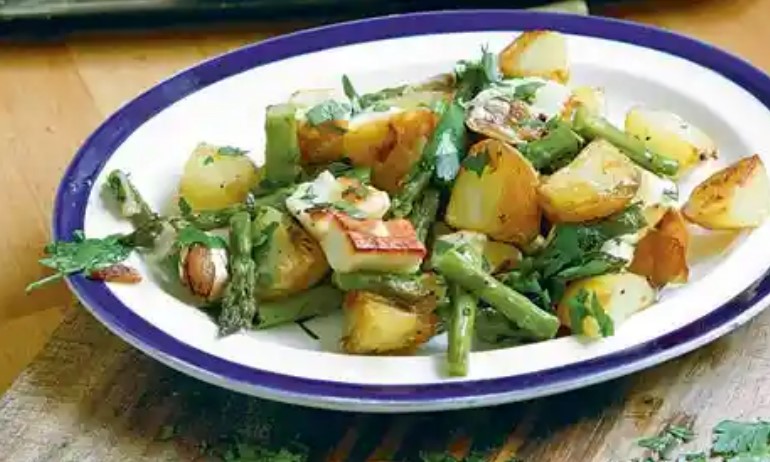
Serves 2-3
Ingredients
600–700g potatoes, scrubbed or scraped
3–5 garlic cloves, unpeeled, bashed
3 tablespoons olive oil
400g asparagus
225g halloumi
½ lemon
salt and freshly ground black pepper
2 tablespoons roughly chopped flat-leaf parsley, to garnish
Method
Preheat the oven to 190C. Cut the potatoes into small chunks. Put them in a large roasting tray with the garlic, olive oil and some salt and pepper, and toss well.
Roast for 30 minutes.
Meanwhile, snap the woody ends from the asparagus and cut the spears into 3–4cm lengths. Cut the halloumi into 2cm cubes.
After the 30 minutes is up, take the potatoes from the oven, add the asparagus and halloumi, and toss to combine. You don’t want the tray to be too crowded – everything should be in a single layer. Return the tray to the oven for a further 15 minutes, or until the asparagus is tender and the cheese is starting to caramelise.
Add a generous squeeze of lemon juice and toss everything again, then transfer to a serving dish. Scatter with parsley, and another grind of black pepper. Bring to the table along with the remains of the lemon half, and some more olive oil, so that people can adjust the flavours to their liking. Serve with wedges of sourdough bread.
Recipe adapted from Hugh Fearnley-Whittingstall, The Guardian, 7 Sept. 2012.
A Recipe from Rebecca: Spinach, Feta and Butter Beans
I recently listened to a fascinating episode of BBC Radio 4’s The Food Programme about ‘How Spain Does Beans’. The programme explained, among other things, why beans in a jar taste so good. Inspired by the programme I bought a jar of butter beans from Aubrey Allen. They cost more than beans from a tin, but they were really good. We’ve now eaten our way through several more jars, and I recommend them enormously for this or any recipe calling for butter beans. On the other hand, it’s also very, very good with ordinary tinned beans.
We ate this for diner with griddled asparagus and some roasted carrot and garlic mash.
Now, sorrel. If you can lay your hands on any of this fibrous, red-veined leaf, use it in place of some or all of the spinach. Since sorrel has its own sour, lemony flavour, you can reduce the lemon juice if you’re using sorrel.
Fried Butter beans with Feta, Sumac and Spinach or Sorrel
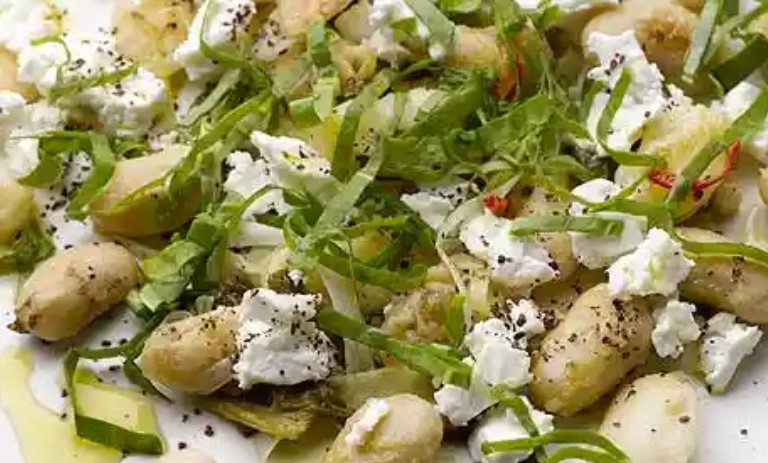
Serves 4.
Ingredients
60g butter
900g tinned or jarred butter beans, drained and rinsed
8 spring onions, halved lengthwise
1 garlic clove, peeled and mashed to a paste with ½ teaspoon salt
1-2 fresh red chiles, sliced thin (optional)
200g shredded spinach or, if you can get it, sorrel—or a mixture of both
3 tablespoons lemon juice (if you can get sorrel reduce this to about 1½ tablespoons)
150g feta, broken into pieces
2 teaspoons sumac
handful of chopped dill
olive oil, to drizzle over the top
Method
First fry the butter beans: heat a bit of the butter in a frying pan over medium-high heat. Add enough beans to cover the bottom of the pan in a single layer and fry for 1-2 minutes on each side, until the skin is golden brown and blistered. Remove to a large bowl and cook the remainder of the beans in the same fashion, adding more butter to the pan as necessary.
When the final batch of beans is almost done, add the spring onions, garlic, and chiles (if using), along with almost all of the spinach or sorrel. Keep back a little of the spinach or sorrel for a garnish.
Sauté everything together for another minute or two, and then return the other beans to the hot pan and mix everything together.
Remove from the heat and add the lemon juice. Scatter the feta over the top, sprinkle on the sumac, and top with the reserved spinach or sorrel, as well as the dill. Finish with a drizzle of olive oil and serve.
Recipe adapted from Yotam Ottolenghi, Plenty (2010).
Rebecca’s Recipe of the Week: A Falafel Salad
A Falafel Salad
The New York Times describes this as the salad equivalent of a falafel sandwich. It combines tahini, mint, cucumber, and crunchy pita with spicy, warm chickpeas. It’s really good. If you don’t want to mess around with cooking the kale, you could also use salad greens.
Spiced Chickpea Salad With Tahini and Pita Chips
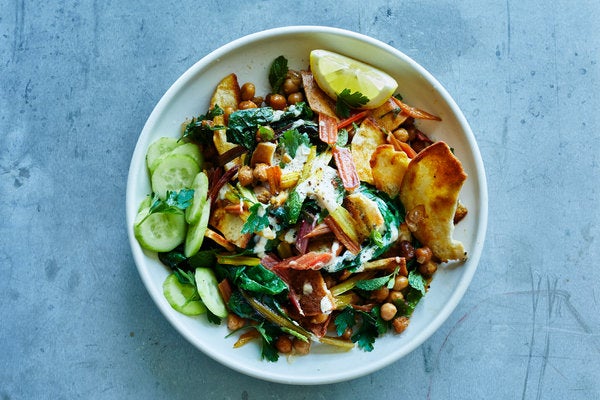
Serves 4
Ingredients
For the chickpeas
2 tins of chickpeas, well drained, or the equivalent of your self-cooked chickpeas
about 180ml olive oil
2 garlic cloves, minced
2 teaspoons ground cumin, or 1 teaspoon each ground cumin and ground coriander
1 teaspoon sweet smoked paprika
Salt and pepper
For the tahini sauce
5 tablespoons (80ml) tahini
freshly squeezed juice of 1 lemon, plus more to taste
1 garlic clove, minced
water, as needed
To finish
Olive oil, for cooking
About 30g kale, chard or spinach, well washed and thick stems removed
180g pita chips (see Tip)
Handful of roughly chopped flat-leaf parsley
Handful of roughly chopped mint
1 cucumbers, thinly sliced
Lemon, cut into wedges
Preparation
Prepare the chickpeas: Preheat your oven to 220C. Pour the chickpeas into a small baking dish, about 15cm x 20cm. The chickpeas should be crowded together in a thick layer, not spread out. Pour in olive oil until chickpeas are just covered. Stir in the garlic, cumin, paprika, and 2 big pinches each of salt and pepper. Bake until oil is bubbling around the chickpeas and they are turning reddish-brown, 35 to 40 minutes. Set aside to cool.
Meanwhile, make tahini sauce: Pour the tahini into a bowl and whisk in lemon juice and garlic. The tahini will thicken and clump. Slowly whisk in the water, a little at a time, until the sauce becomes smooth, creamy and pourable. Taste and season with salt, pepper and more lemon juice, if desired. Set aside.
Cook the greens: Place a large frying pan over medium heat and drizzle lightly with olive oil. When hot, add the greens in batches, along with a big pinch of salt. Stir until wilted and tender and set aside.
Assemble the salad: in a large bowl, gently mix the chickpeas and their cooking oil with the cooked greens, half the pita chips, and the chopped herbs. Add the cucumber slices and drizzle with half the tahini sauce. Scatter the remaining pita chips on top. Arrange the lemon wedges around the side and serve, passing extra tahini sauce at the table.
Tip
It’s easy to make pita chips from stale pita bread. Cut each pita bread into triangles and separate the top and bottom layers. Heat 2 tablespoons olive oil in a large skillet over medium-high heat. When the oil shimmers, add the pita triangles and cook, stirring often, until golden brown. Reduce the heat as needed to prevent scorching.
Recipe adapted from New York Times Cooking (2019)